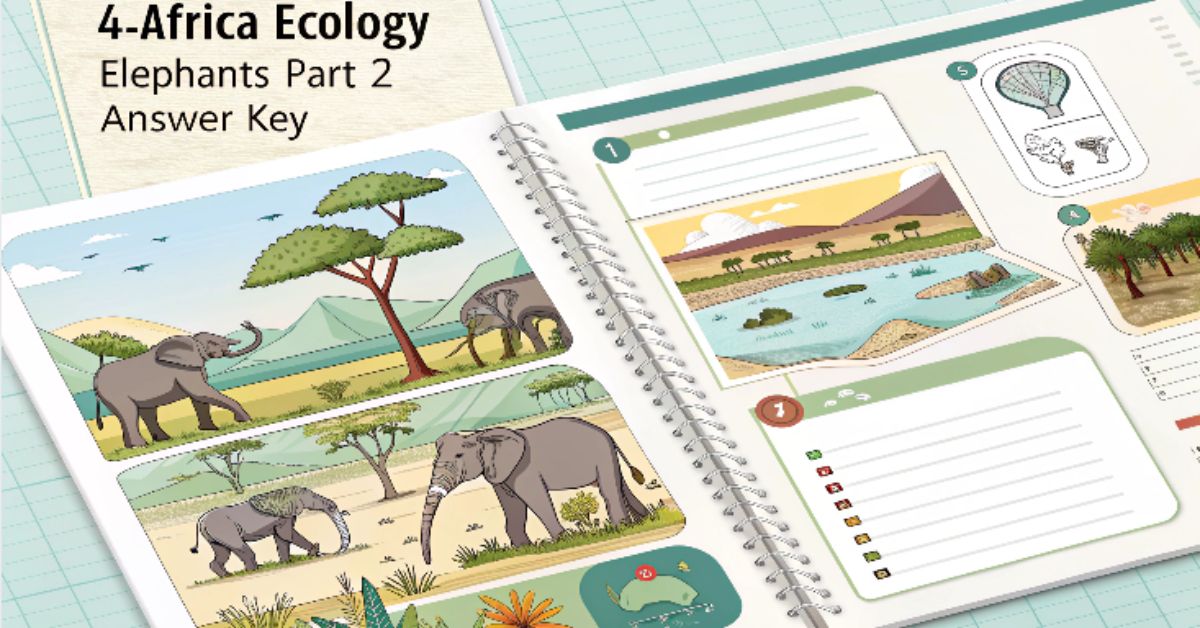Elephants are one of the most iconic and majestic animals in the world. Known for their impressive size, remarkable memory, and complex social structures, they play a pivotal role in the ecology of Africa. This article provides an in-depth exploration of the “interactive notebook 4_africa ecology elephants part 2 answer key,” offering insights into how these animals contribute to their environment and the lessons students can learn through interactive learning resources.
The interactive notebook in the context of African ecology focuses on elephants’ behavior, their impact on ecosystems, and the efforts to conserve them. Part 2 of this resource delves deeper into these topics and encourages students to understand the intricate relationships between elephants and the environment.
In this guide, we will cover key concepts, activities, and questions included in the “interactive notebook 4_africa ecology elephants part 2 answer key.” By the end of this article, you will not only have a better understanding of elephants’ roles in the ecosystem but also the resources needed to help students grasp these concepts effectively.
The Importance of Elephants in Africa’s Ecology
Elephants are herbivores and are known as keystone species in their ecosystem. This means they have a disproportionate impact on their environment compared to their numbers. Elephants influence the structure of the African landscape, contributing to biodiversity in several ways:
- Vegetation Control: By eating a variety of plants, elephants help maintain the balance of vegetation. Their feeding habits prevent any single species from becoming too dominant.
- Water Availability: Elephants dig wells with their tusks, allowing other animals to access water in dry regions.
- Seed Dispersal: Through their droppings, elephants help spread seeds, promoting plant growth and maintaining the health of their habitat.
Understanding these ecological roles is essential for students and conservationists alike. Through the “interactive notebook 4_africa ecology elephants part 2 answer key,” students are encouraged to think critically about these connections.
Key Themes in the Interactive Notebook 4_Africa Ecology Elephants Part 2 Answer Key
1. Introduction to Elephants and Their Habitat
Elephants live in a variety of habitats across Africa, including savannas, forests, and deserts. They are highly adaptable and can survive in various environmental conditions, though they are most commonly found in sub-Saharan Africa.
In Part 2 of the interactive notebook, students are asked to explore different habitats of African elephants. They will discover how elephants have adapted to these environments, both physically and behaviorally. Questions such as “How do elephants contribute to the savanna ecosystem?” guide learners to engage with these ecological concepts.
2. Social Structure and Behavior of Elephants
One of the most fascinating aspects of elephants is their complex social structure. Female elephants live in matriarchal groups led by the oldest female, while males typically live solitary lives or form smaller bachelor groups. The interactive notebook encourages students to explore how these social structures impact elephant behavior and their survival in the wild.
Activities in this section might include filling out a chart on elephant social behavior, answering questions on elephant communication (such as trumpeting and low-frequency rumbles), and reflecting on how these behaviors help elephants survive in challenging environments.
3. Elephant Conservation Efforts
Elephants face numerous threats, including poaching for their ivory tusks, habitat loss due to human encroachment, and conflicts with local communities. Part 2 of the interactive notebook addresses these conservation challenges and highlights global efforts to protect elephants.
Students will learn about anti-poaching measures, wildlife sanctuaries, and international agreements such as the Convention on International Trade in Endangered Species (CITES). They will be asked to analyze the effectiveness of different conservation strategies and discuss ways to ensure the survival of elephants for future generations.
Interactive Activities in the Notebook
The “interactive notebook 4_africa ecology elephants part 2 answer key” provides a variety of activities that are both educational and engaging. Here are some examples:
4. Matching Activity: Elephant Adaptations to the Environment
Students match different elephant adaptations (such as large ears for heat regulation) with the environmental challenges they help the animals overcome. This activity fosters a deeper understanding of the connection between an animal’s physiology and its environment.
5. Critical Thinking Questions
The notebook includes open-ended questions that encourage students to think critically about elephants’ role in the ecosystem. For example, “If elephants went extinct, how might the ecosystem be affected?” These types of questions help learners analyze the broader impact of losing such an important species.
6. Research and Presentation
Students are tasked with researching a specific aspect of elephant ecology, such as their migratory patterns, dietary habits, or the effects of climate change on their populations. Afterward, they present their findings to the class, encouraging collaborative learning and reinforcing research skills.
How Elephants Shape Africa’s Ecosystems
Elephants’ activities have a profound effect on the landscape and the species that share their habitat. The interactive notebook guides students to explore these relationships through activities and assignments designed to highlight the importance of elephants as ecosystem engineers.
7. Impact on Vegetation
By feeding on trees and shrubs, elephants help prevent the overgrowth of certain species, which could otherwise dominate and reduce biodiversity. This activity asks students to draw connections between elephant behavior and the health of the landscape.
8. Water Conservation and Habitat Creation
Elephants play a critical role in maintaining water sources. By digging water holes in dry seasons, they help create habitats for other species. Students can visualize this by mapping out elephant migration patterns and water sources.
Related Terms to Understand in the Interactive Notebook 4_Africa Ecology Elephants Part 2 Answer Key
To ensure a comprehensive understanding, students are introduced to several related terms that provide context for elephant conservation:
- Habitat Fragmentation: The breaking up of habitats into smaller, isolated patches, often caused by human activity.
- Keystone Species: Species that have a disproportionately large impact on their environment relative to their abundance.
- Ecological Balance: The equilibrium between species within an ecosystem, maintained by factors like food chains and predator-prey relationships.
- Biodiversity: The variety and variability of life forms within a given ecosystem or on Earth in general.
These terms provide critical context for students as they engage with the content in Part 2 of the notebook.
Common FAQs about the Interactive Notebook 4_Africa Ecology Elephants Part 2 Answer Key
1. What is the “Interactive Notebook 4_Africa Ecology Elephants Part 2 Answer Key”?
It is a comprehensive educational resource that helps students understand the ecological importance of elephants in Africa through engaging activities, questions, and interactive learning strategies.
2. How do elephants impact Africa’s ecosystems?
Elephants help maintain vegetation balance, create water holes, and disperse seeds, all of which contribute to the health of their ecosystems.
3. What are some of the key activities in the interactive notebook?
Key activities include matching elephant adaptations, answering critical thinking questions, and researching specific aspects of elephant ecology.
4. Why is elephant conservation important?
Elephants are essential to maintaining biodiversity and ecosystem health. Protecting them ensures the survival of many other species that depend on their ecological contributions.
5. How does the interactive notebook support learning?
The notebook uses a hands-on approach to learning, with interactive activities that make complex ecological concepts more accessible to students.
6. What are some conservation efforts highlighted in the notebook?
Conservation efforts include anti-poaching initiatives, habitat preservation, and international agreements like CITES.
7. Can this resource be used for homeschooling?
Yes, the interactive notebook is a versatile tool that can be adapted for both classroom and homeschooling environments.
8. What age group is the interactive notebook designed for?
The notebook is designed for middle school to high school students, but can be adapted for younger learners.
9. How do elephants communicate with each other?
Elephants communicate using vocalizations, body language, and low-frequency rumbles that travel long distances.
10. How can students get involved in elephant conservation?
Students can get involved by supporting conservation organizations, spreading awareness, and learning more about sustainable practices.
Conclusion: Teaching the Importance of Elephants Through Interactive Learning
The “interactive notebook 4_africa ecology elephants part 2 answer key” is a vital tool for educators and students alike, offering a comprehensive and engaging way to understand the role of elephants in Africa’s ecosystems. Through the activities, students not only learn about these majestic creatures but also develop critical thinking and research skills that will help them better understand and appreciate the natural world.
By providing in-depth resources and thoughtful analyses, this interactive notebook allows learners to connect the dots between biology, conservation, and environmental stewardship. Whether you’re an educator seeking new ways to teach ecological concepts or a student eager to explore the wonders of Africa’s wildlife, this resource offers everything needed to foster a deeper connection to one of the world’s most fascinating species.


